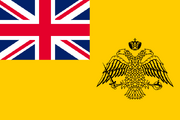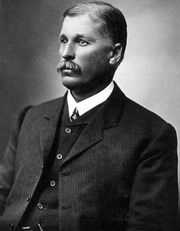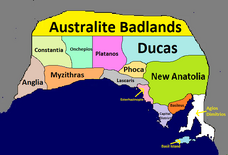
|
The following Differently page or section is a proposal.
It has not been ratified and is therefore not currently part of the Differently timeline. You are welcome to correct any errors and/or comment on the talk page. If you add this template to an article, please don't forget to mention this proposal on the main discussion page. |
| Federation of Mystras Australis Ομοσπονδία Μυστρᾶς Αυστραλίς Timeline: DifferentlyOmospondía Mystras Australis | |||
|---|---|---|---|
|
|||
| Map of Mystras Australis and cities
|
|||
| Capital | Theodora | ||
| Official languages | Greek, Various Aboriginal Dialects | ||
| Ethnic groups | Mavri, Greeks, Aboriginals | ||
| Religion | Orthodox Christianity | ||
| Demonym(s) | Australite | ||
| Legislature | Australite Assembly | ||
| Currency | Australite Drachma | ||
Mystras Australis, officially the Federation of Mystras Australis, is a Greek-speaking nation located in Southern Australia. Settled by Byzantine Explorers in the early 17th century to act as an outpost to the empires of east Asia, the nation got its name from the cliffs of the Great Australian Bight which resembled the steep mountains of Mystras in the Byzantine mainland. The nation gained independence in the late 18th century after a successful revolution against Byzantine rule. The prolonged revolution would bankrupt the Byzantine Empire and result in the Byzantine Revolution and subsequent Republic of Byzantium.
History
Indigenous/Pre-Colonial History
Aboriginals were descended from people who migrated from Asia onto the Australian continent during the land-bridge period of the Pleistocene epoch. Aboriginals settled the continent roughly 50,000 years ago.
Unlike the pre-colonial history of New Holland and the other Australian nations, not much is known about the Aboriginals who originally inhabited Mystras Australis. This is largely due to the brutality of Byzantine integration which eradicated tribal identity and history.
Colonial Era (1601 - 1790)
Arrival + Early Settlements
With the discovery of the New World in 1492, the western nations had discovered alternative trade routes through the new world and did not need to rely on the access of the Byzantine-controlled Eastern Mediterranean for trade routes. In order to remain competitive with the western trade markets, Byzantine trade rapidly expanded towards the East and with the Hindu-Buddhist Bali Kingdom in modern day Malaysia. It was trade through this area which would lead to the discovery of the Australian continent on June 5th, 1601 by Byzantine explorer Eutropius Lascaris.
Lascaris and another crew would land on the continent in what would become modern-day northern Swan River Colony on October 7th, 1601. The group, finding the Northern part of the continent to be barren in resources and filled with desert, would voyage South and navigate the continent until eventually settling an outpost in the Southern portion of the continent on April 6th, 1602 after nearly a year of navigating the continent. It was at this newly established outpost that the Byzantine explorers would officially make contact with the Aboriginal tribes in the region, making contact with tribes such as the Adnyamathanha near Lake Theodora. The discovery of new people and a new continent brought merchants and missionaries from across the Empire heading towards the Australian continent. Basileus Ferenikos II would declare the new continent the Continent of New Anatolia in 1610. By then, the Dutch and other European powers had appeared on the eastern side of the continent in what would become New Holland. The race for the continent had begun.
Romanization and Conquest
Unlike the Dutch and British Empires who practiced settler colonialism and intended to eradicate the Aboriginal populations and replace them with ethnic Britons and Dutchmen, the Byzantine Empire, being a continuation of the Roman Empire, used Romanization in order to integrate the Aboriginal tribes. The Byzantine Settlers, being overwhelmingly traders and missionaries, also began miscegenation which helped further the integration of the Aboriginal tribes into Byzantine religion and culture. It was this miscegenation which created the Mavri (meaning "black" in Greek), which refers to a person of Byzantine and Aboriginal descent. Due to the Byzantine Empire not having any restrictions on miscegenation in the same way other colonial societies did, the Mavri population grew expotentially and became a majority in Mystras Australis around 1700.
While some tribes complied with the forced integration, other Aboriginal tribes resisted. Aboriginal tribes such as the Narungga would conduct raids against Byzantine Kleisoura and would kill missionaries attempting to make contact, fearing the obliteration of their culture and way of life. Tribes that resisted Byzantine rule met brutal responses. The Byzantine settlers and mercenaries on the continent would massacre entire tribes, erasing the tribe's culture and history in the process. One of the most well known examples of this brutality came in the Lake Basileus Massacre of 1643 in which Byzantine soldiers surrounded members of the Ophis tribe at Lake Basileus and had the adult men and women massacred, taking the children back towards the cities in order to have them intergrated and Romanized. The Byzantines were so effective as massacring and erasing tribes that the indigenous name of the Ophis tribe remains unknown, with the name Ophis being given to them by the Byzantines to derogatorily describe them as snakes.
Theme of Mystras Australis
By 1680, the population of Mystras Australis was estimated at 600,000 with the bulk of the population being based around the coastal settlements of Theodora and Agios Dimitrios. This exponential growth would see the unorganized territory of New Anatolia be organized into the Theme of Mystras Australis. (Latin for South Mystras or the land south of Mystras). Despite it's distance, Mystras Australis largely functioned in a similar way to the other Byzantine themes on the mainland. Mystras Australis' administrative theme was one of the most heavily militarized in the empire, surpassing even the themes on the Persian border. This was largely due to the need for defense against various Aboriginal tribes and the competing British and Dutch settlers on the continent.
The Theme of Mystras Australis also brought new resources from the Australian continent towards the Byzantine mainland. The discovery of copper and gold in the northern part of the Theme brought further population growth. It was estimated by the time of the 1790 Revolution that the population of Mystras Australis was 2 million.
Great Revolution of 1790
As more settlers arrived in Mystras Australis and as the economy of the region grew more prosperous and more developed, a cultural and political rift would occur between the Theme of Mystras Australis and the central government in Constantinople. The culture of market liberalism which had developed in large coastal cities such as Theodora also contrasted with the medieval land tax system in place in the empire. As a result, the Australite merchant class was often at odds with the taxation policies implemented by Constantinople.
Due to contact with traders from New Holland and the British Swan River Colony, enlightenment values would spread to the citizens of the colonies. The successful American Revolution which established the United States also reached Mystras Australis by 1776. Despite demonstrations in front of the administrative building in Theodora, the Theme's government largely aligned with Constantinople and continued the land tax policies.
The Great Revolution would officially begin on February 17th, 1790 after a group of delegates from the Australite cities met in Agios Dimitirios to discuss the future of Mystras Australis. The convention voted in favor of declaring independence and by March 1st, the declaration had been ratified and Australite militias formed to drive the Byzantine military from Mystras Australis. The militias largely consisted of Mavri farmers and miners, and the middle class. Byzantine loyalists, on the other hand, were mostly ethnically Greek and largely made up professional positions within the Theme of Mystras Australis.
Unlike the drawn out American revolution which took multiple years, the Great Revolution of 1790 was a quick revolution which lasted from February to August. This was due to the lack of Byzantine troops in Mystras Australis and the Byzantines losing hegemony over the East Mediterranean due to the rise of the Empire of West Persia. Unlike relations with the Sassanid Empire which remained close to the Byzantines and allowed Byzantine troops and ships through Egypt, the West Persians had a more adversarial relationship with the Byzantines. As a result, West Persian control of the east Mediterranean meant the Byzantines lacked proper supply lines to reinforce garrisons at the Colony. After months of holding out, the Garrisons in Theodora fell on August 17th, 1790 with the city of Agios Dimitrios falling 2 weeks later.
Republic of Mystras Australis (1790 - 1848)
With the Byzantine military driven out by the Australites, Mystras Australis would be consolidated into a unitary republic based out of the city of Agios Dimitrios. During the early days of independence, Mystras Australis was economically and politically isolated. With aboriginal assaults from the north and border skirmishes with the British and Dutch colonies, Australite workers, especially farmers, suffered tremendously. There was little effort made by the unitary government to protect farmsteads as the majority of the population and political capital was based on the coastal cities in the southern region of the country.
Ducas Uprisings
It was the unitary government ignoring the issues of farmers which would result in political tension between rural and urban Australites. These divisions would culminate in several farmer uprisings in the 1840s in what would become known as the Ducas Uprisings led by Mavri farmer Palladius Ducas. Once the farmer militias reached the gates of Agios Dimitrios, a new constitution would be drafted on April 10th, 1848. The New Constitution, known as the April 10th Constitution, would abolish the unitary republican government of Mystras Australis and instead establish a federalist form of government which gave greater political and economic autonomy towards the more rural provinces of Mystras Australis. It also established a proper Australite military to defend the rural provinces against Dutch, British, and Aboriginal adversaries.
First Federation of Mystras Australis (1848 - 1916)
With a proper federation and military established, Mystras Australis would begin a period of economic growth and rapid industrialization from the mid 19th century until the early 20th century. This was brought on by increased trade from the New Hollanders, Dutch, French, and British and the discovery of gold reserves in the northern part of the country which only furthered trade growth.
Northern Australite War (1876 - 1878)
Industrialization also resulted in the growth of railroads which connected cities and allowed for farmers to ship more produce towards the cities for profit. This resulted in the expansion of farms which began to intrude into the isolated aboriginal lands in the northern outback of Mystras Australis. Tribes which resisted initial Romanization were now in conflict with the Australite government once again. Tribes such as the Kokatha were decimated by the fighting. Even with advanced rifles sold to them by Dutch merchants, the tribal community ended up being massacred by the more technologically advanced Australite army with the conflict itself only lasting 2 years before the northern tribes were unable to continue fighting. Continuing the legacy of the Byzantine Empire, the Australites forcefully Romanized the remaining aboriginal tribes and began the process of obliterating aboriginal culture once again.
Reconciling with Byzantium + Buildup to the Great War
Starting in the 1840s, efforts were made by the Australite government to properly reconcile with Byzantium and gain recognition and open proper relations with the nation. These efforts were blocked by the more nationalistic Byzantine prime ministers such as Andreas Metaxas and Alexandros Mavrokordatos who were still resentful towards the Australites for blocking off Byzantine trade efforts in southeast Asia. Mystras Australis would finally be recognized by Byzantium on June 10th, 1860 by the government of Constantine Kanaris.
With the opening of relations between Byzantium and Mystras Australis, trade and an economic bond would develop between both nations. This economic relationship would also bring Mystras Australis closer with other Byzantine allies such as the German Empire. These ties with Byzantium and Germany would eventually bring Mystras Australis into the Great War in 1914.
Involvement in the Great War (1914 - 1916)
Aside from increased economic dependency on Germany and Byzantium, there were other factors which influenced the decision to align with the Central Powers. One of these reasons was tension with the British Dominion of Swania that bordered Mystras Australis to the west. This tension came about due to the border between the two nations being poorly defined with Swanian settlers illegally crossing the border into Australite territory which disrupted life in the western part of the country.
For these reasons, Mystras Australis would officially declare war on Swania on November 2nd, 1914 and invaded Swania through the Great George Desert. The Australite army under the command of general Alexius Bardas made progress in the grasslands of the George Desert, expelling Swanian settlers as they captured settlements in easten Swania. By early 1915, the front in the George Desert had stagnated as both sides struggled to break through in the vast expanse of the Great George Desert. Despite the stalemates in the desert, the Australite military made great advances along the southern coast of the continent. Around this time, a British naval fleet from India would be restationed to the Dominion of Swania in order to help defend it against the Australite invasion by blockading Mystras Australis in April of 1915. Despite the successes of the Australite military on land, the Australite navy was severely outmatched by the British-Swanian navy which destroyed a large portion of the Australite fleet within Theodora Harbor on June 7th, 1916.
The destruction of the fleet in Theodora would pave the way for the British-Swanian naval invasion which would follow. The British-Swanian troops would navally invade the city of Theodora on July 10th, 1916, capturing the government before they could evacuate the city. The Australite army, without leadership, surrendered a few days later. Following the surrender after the fall of Theodora, the British military would begin occupation of Mystras Australis starting in late 1916.

Flag of the Colony of East Swania used during the British Occupation
British Occupation (1916 - 1924)
After the occupation by the British, Mystras Australis would be reorganized into the Colony of East Swania with plans to integrate it with the rest of Swania, Jamesland, and Brisbane into the proposed Dominion of Australia to assert British hegemony over the continent. British rule in Mystras Australis was short, but marked with political repression. The British military occupied the major cities directly with military governors ruling over the rural Australite provinces.
The occupation would officially become to an end in the midst of the Anglo-American War in which the British would withdraw 15,000 troops from Mystras Australis to reinforce the Pacific front and assist their Japanese allies in 1922. 2 years later, remnants of the Australite army would reunite under the command of general Vitalius Kerularios who would retake Theodora and Agios Dimitrios in late 1923. By January 17th, 1924; the British forces in Mystras Australis began retreating in order to reinforce Swania and prevent Mystras Australis from entering the war on the American side.

Vitalius Kerularios, despite his military titles and title of "Strategos Autokrator", wore suits and ties and styled himself as a modern leader
Australite Social Republic - Kerularios Junta (1924 - 1950)
Rise to Power
After leading a successful war against the British occupation, General Vitalius Kerularios would become venerated by the Australite citizens. His march into Agios Dimitrios would become an iconic part of Australite history and the turning point against British hegemony on the Australian continent. On June 17th, 1924, Kerularios would proclaim the Australite Social Republic and would move the capital inland to the city of Phoca in order to prevent another naval invasion into the capital. The Republic's power would be consolidated by Kerularios who would style himself Strategos Autokrator of Mystras Australis.
Foreign Relations
In 1926, the British would re-recognize Mystras Australis and the nation would rejoin the League of Nations under the Junta. The Junta cracked down on minorities within Mystras Australis such as the English minority in the western part of the country and the remaining Aboriginal populations. Despite protest from the British, the international community largely turned a blind eye to the human rights violations of Mystras Australis as many nations did not want to jeopardize trade with Mystras Australis due to the nation's profitable natural resources. During this time, the British also entered a period of decline being unable to retain their colonies after their defeat in the Anglo-American War and massive resources poured into the Great War and were unable to properly oppose the Kerularios junta. As a result, Kerularios largely conducted his affairs unopposed.
During the Cold War, Mystras Australis alligned with the United States and the western allies against the Soviet Union and the Eastern Bloc and began a crackdown of leftist groups and organizations which began in the mid-1930s and lasted until the fall of the government in 1950.

An Australite army tank flanks a group of student protestors in the city of Phoca, moments before the Phoca Polytechnic Massacre (1949)
June Revolution - The end of the Junta
The crackdown of opposition in the 1940s as well as a stagnant economy caused by excessive military spending would turn people against Kerularios' regime. The opposition consisted of college students, aboriginals, democracy activists, and people suffering economically. On June 18th, 1949; massive protests would erupt in cities across the country, including the capital of Phoca. Kerularios would order the military fire upon the protestors occupying Phoca Polytechnic University, resulting in what is now known as the Phoca Polytechnic Massacre which left 18 students dead and 40 injured.
With news reaching the international community, the League of Nations voted on a resolution to place economic sanctions on Mystras Australis under the Kerularios government stepped down. The massacre in Phoca would also result in the protests turning into riots and part of the military defecting towards the opposition. After 2 weeks of unrest, Kerularios caught trying to flee the country into New Holland and was captured on July 2nd, 1949 with him being removed from power immediately. A provisional government took over the Australite Social Republic until it was formally dissolved on January 1st, 1950 and the Federation of Mystras Australis was restored.
Kerularios would be executed by firing squad in Phoca on January 18th, 1950.
Second Federation of Mystras Australis (1950 - Present)
Restoration of Democracy + Vatatzes Presidency
With the Federation being restored on January 1st, so was the Constitution and the restoration of Democracy. Due to the suppression of left wing parties under the Kerularios regime, left wing parties would ride a wave of popularity to power. This would culminate in the election of the Party of June in 1951 with progressive reformer Leo Vatatzes serving as President. Under the Vatatzes Presidency, greater political freedoms were granted to political dissidents and ethnic minorities which had historically suffered under the various governments of Mystras Australis. This would result in the recognition of several Aboriginal tribes which had been at war with the Australites for centuries such as the Anangu to the north.
Though democracy was restored, there remained a general sense of fear and instability among the general population. Many feared that military officials were still loyal to the values of the Junta and feared that the Democracy could be overthrown at any moment. Economic instability also remained a problem as the Vatatzes government pursued an economic policy of liberalization, privatizing junta run industries in order to bring foreign investment back into Mystras Australis. Despite these issues of contension, Vatatzes remained popular among the citizenry due to his efforts to connect to the people of Mystras Australis and their interests. He would serve 6 years as President before resigning in 1956 citing declining health.

A map of the nations of the Australian Continent
Australian Economic Community + Continued Growth (1960s - 1990s)
On July 6th, 1960, Mystras Australis along with New Holland, Jamesland, and Swania would become founding members of the Australian Economic Community (AEC). Australite participation in the Australian Economic Community would also help repair the image of the nation on the international stage and on the Australian continent. Mystras Australis would also begin to see a tourism boom brought on by the construction of the Pan-Australian Railway and the formation of the Australian Transportation Authority which brought tourists from all over the continent to the country.
While economic growth brought more wealth, the wealth remained largely concentrated in the hands of travel corporations which profited the most off of the initial tourist booms of the 70s and 80s even while railroad workers were making insufficient wages. This would result in the government taking more progressive reforms such as nationalizing over 30 railroad companies through the Railroad Protection Act of 1994. This act remained extremely controversial and divisive throughout the 90s and early 2000s, with Conservatives fearing that government takeover of the railroads would drive up the debt and result in the government bleeding its budget surplus in maintaining the railroads.
21st Century
Going into the 21st century, Mystras Australis enjoyed economic prosperity and a status as a regional economic and military power on the Australian Continent. In 2003, the capital of the Australian Economic Community would be moved to Theodora. During this time, Mystras Australis would also begin to emerge as an economic power on the world stage as well with mining companies such as the Phocas Corporation becoming the nation's biggest multinational corporation.
Despite continued economic growth, Mystras Australis would suffer political turmoil throughout the mid 2000s to early 2010s after President Andronicus Melodus would be forced to resign in 2006 amid a corruption scandal.
Demographics

Photo of a Mavri woman (2010)
Ethnic Groups
Mavri
The largest ethnic group in Mystras Australis are the Mavri (meaning "black" in Greek due to their darker skin). Mavri refers to a person of both Greek and Aboriginal descent and they make up roughly 70% of Mystras Australis' population. The Mavri were a result of many factors during the early colonial period of Mystras Australis such as most of the Byzantine settlers being male and the Roman practice of Romanization which sought to intergrate the Aboriginal tribes into Byzantine-Roman culture rather than eradicate them and replace them with settlers as the British and the Dutch did.
Greeks
The second largest ethnic group within Mystras Australis are Greeks. The term Greek in the Australite sense are those who can trace their ancestry exclusively to the Byzantine Greek settlers who arrived in Mystras Australis and did not miscegenate with the Aboriginal peoples. Greeks roughly make up 20% of the Australite population and are concentrated on the coasts and cities where Aboriginals were not found. Prior to the Great Revolution of 1790, the Greek minority enjoyed more political power of the Mavri majority of Mystras Australis.
Russian and Armenian Australites
Russian and Armenian Australites are the second largest minority population behind the Greek Australites. The majority of Armenian and Russian Australites arrived to Mystras Australis in the 1930s and 1940s as religious refugees escaping the state atheism of the Soviet Union.

Provinces of Mystras Australis
Provinces by Population
| Pop.
Rank |
Province Name | Population | Capital |
|---|---|---|---|
| 1 | Agios Dimitrios | 13,493,201 | Agios Dimitrios |
| 2 | New Anatolia | 10,231,291 | Asklelis |
| 3 | Capital District | 8,410,931 | Theodora |
| 4 | Esterhazinople | 5,420,102 | Esterhazinople |
| 5 | Basileus | 3,420,102 | Lake Basileus |
| 6 | Myzithras | 3,100,340 | Pentadaktylos |
| 7 | Lascaris | 2,984,938 | Lascaris Beach |
| 8 | Phoca | 1,060,120 | Phoca |
| 9 | Anglia | 960,302 | Komotini |
| 10 | Basil Island | 405,203 | Agios Nikolaos |
| 11 | Ducas | 398,030 | Ilia |
| 12 | Platanos | 355,384 | Livadaki |
| 13 | Constantia | 298,012 | Constantia |
| 14 | Onchepios | 162,382 | Agios Ioannis |
| 15 | Australite Badlands | 14,302 | Maroussi |
See Also:
| ||||||||||||||||||




